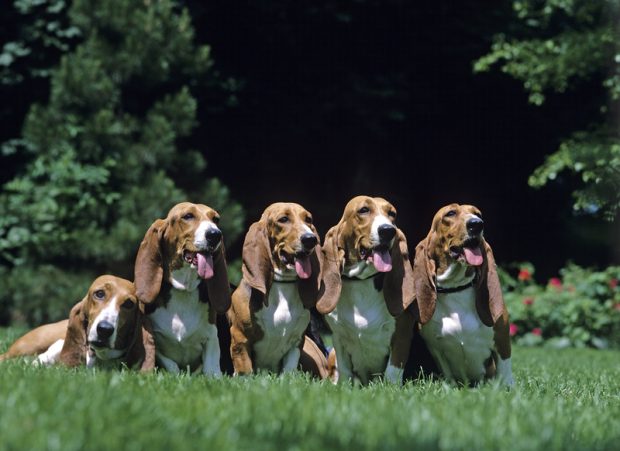
A sad irony is that the Basset Artésien Normand is all that is left of the two breeds that went into its “making, “the Normand and the Chien d’Artois, both now extinct, but both once common in the 17th century.
But we get ahead of ourselves.
In the late 1800s, Basset breeding in France was becoming more purposeful and showing more direction; different “types” started to emerge and be more defined. The most popular hounds came to be the Couteulx type and Lane type (named after their breeders), and a few years later, the Couteulx type was named Basset d’ Artois, while the Lane type was referred to as the Basset Normand. Local breeders combined the front, crooked-legged Normand with the straighter front legged d’Artois in the 1870s, and in 1910, a breed club was formed, both types unified under the same standard with the name Basset Artésien-Normand which was made official in 1924. Colloquially, the breed became known as the B.A.N. Three years after the club’s formation, Léon Verrier took over the leadership, and expressed a goal to strengthen the breed’s Norman character, in contrast to the Artois Hound. The Book of Standards published three years later stated that the “Basset Artesien Normand ought to be only one step away from a Norman type, without a trace of the Artois.” The breeds
Today, the Basset Artésien Normand is not only one of six French basset breeds, but the most common basset breed in the country. This isn’t to suggest that there is a BAN in every house. Breed numbers are lower now than they were when France had a lot of rabbits in mid-1900s and the breed was a popular hare hunter. That was before the myxomatosis virus, a severe and often fatal disease in European rabbits. After the virus spread in France, the number of rabbits decreased, and so did the number of Basset Artésien-Normands.
Though the Basset Artésien Normand is shorter in height than the Basset Hound, lighter in bone, has a rounder eye with less haw, and features a less distinct occiput, what it does have in common with the Basset Hound is that it is also a “walking hound,” which to say that as a hunting dog, it was followed by a hunter on foot. Short legs ensured the dog never got too far ahead of the hunter who could watch with pleasure their dog’s methodical tracking and flushing.
Critics of the breed maintain that while the BAN is a streamlined version of the original lumbering dogs that went into it, the price to be paid is a lack of stamina and a fine tongue. We leave that for owners to debate. Our research finds no quibbling over the Basset Artésien Normand’s marvelous temperament, and all are in agreement that this is an immensely appealing, cheerful hound. Perhaps that is that attracted Napoleon III to the breed because the emperor was an early Basset Artésien Normand fancier, and his interest, if not his patronage, boosted the breed’s popularity in France. He even commissioned Emmanuel Fremiet, a leading sculptor of the day, to sculpt a bronze of his dogs which you can see here.
The breed recognized by the United Kennel Club and the FCI is a good fit for active people who like to take long walks.
